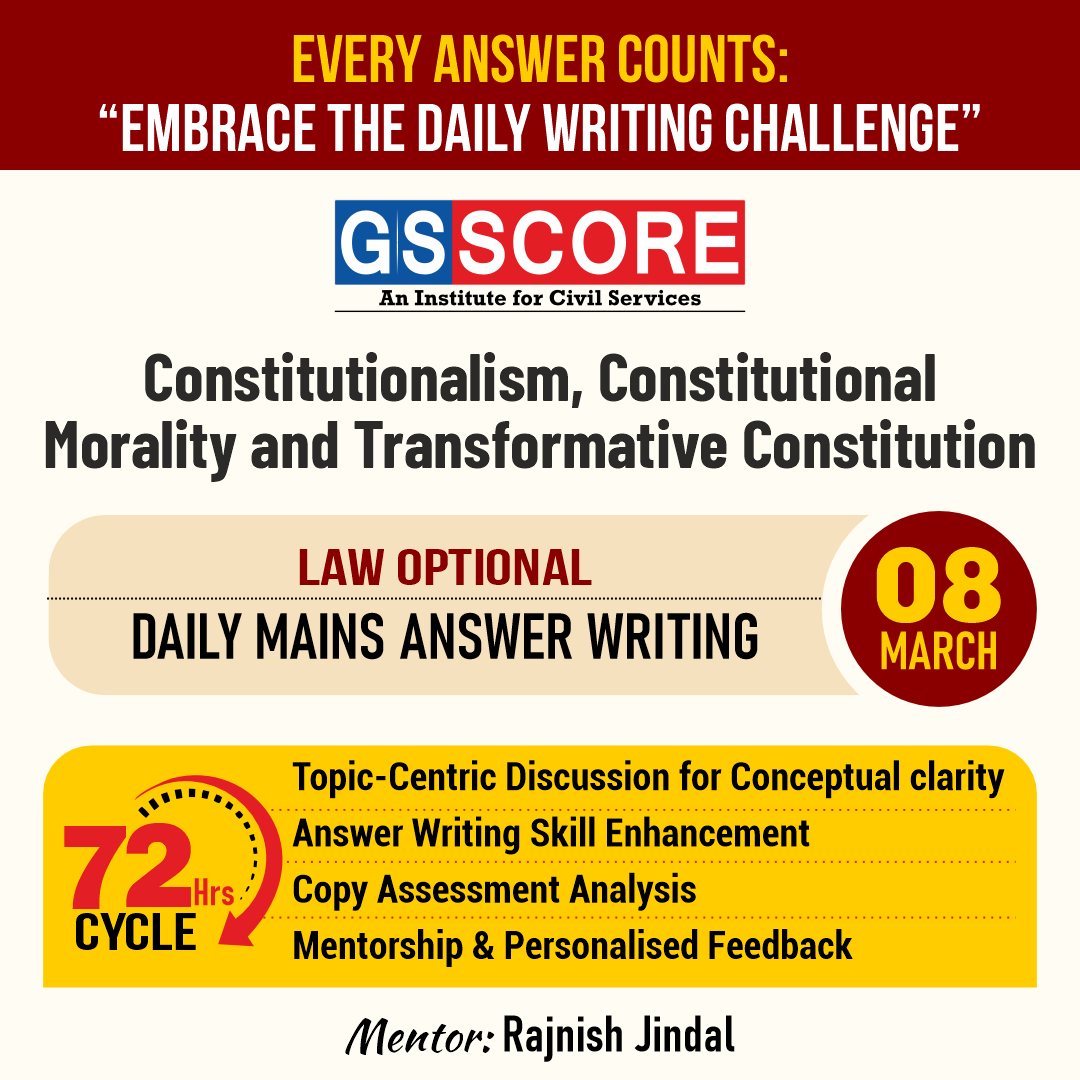

Law Optional (Constitutionalism, Constitutional Morality and Transformative Constitution) by Rajnish Jindal

Instruction:
- There will be 2 questions carrying the First Question is-10 marks Write your answers in 150 words and the Second Question is-15 marks Write your answers in 250 words.
- Any page left blank in the answer-book must be crossed out clearly.
- Evaluated Copy will be re-uploaded on the same thread after 2 days of uploading the copy.
- Discussion of the question and one to one answer improvement session of evaluated copies will be conducted through Google Meet with concerned faculty. You will be informed via mail or SMS for the discussion.
Question #1. Over the last few years, India has witnessed significant changes in its substantive law, ushered in by Supreme Court rulings involving re-interpretations of the Constitution. In view of this, discuss the concept of Transformative Constitutionalism as an instrument in ensuring a more equitable society in India. Comment. 10 marks (150 words)
Question #2. “The doctrine of basic structure has established judicial supremacy in the area of constitutional amendment.” Examine. Explain the principles and policies underlying the doctrine of basic structure. How would you judge the constitutional validity of the amendment deleting the words ‘secular’ from the Preamble of the Constitution. 15 marks (250 words)
(Examiner will pay special attention to the candidate's grasp of his/her material, its relevance to the subject chosen, and to his/ her ability to think constructively and to present his/her ideas concisely, logically and effectively).
STEPS & INSTRUCTIONS for uploading the answers
Step 1 - The Question for the day is provided below these instructions. It will be available at 7:00 AM.
Step 2 - Uploading of Answers : Write the answer in A4 Sheet leaving proper margins for comments and feedback and upload the PDF in MY ACCOUNT section. Click on the option of SUBMIT COPY to upload the PDF.
Step 3 - Deadline for Uploading Answers: The students shall upload their answers by 7:00 PM in the evening same day. The first 50 copies will be evaluated.
Step 4 - Feedback : Mentors will give their feedback for the answers uploaded. For more personalised feedback, join our telegram channel by clicking on the link https://t.me/mains_answer_writing_cse . A one-to-one session will be conducted with the faculty after copy evaluation in 72 Hrs.
Model Answer
Question #1. Over the last few years, India has witnessed significant changes in its substantive law, ushered in by Supreme Court rulings involving re-interpretations of the Constitution. In view of this, discuss the concept of Transformative Constitutionalism as an instrument in ensuring a more equitable society in India. 10 marks (150 words)
The concept of Transformative Constitutionalism as an instrument used by the Court in ensuring a more equitable society which is evident through the prominent examples which include the NALSA judgment, which recognised the rights of the third gender; the Navtej Singh Johar case, which saw an end to decades of criminalisation of homosexuality; the decriminalisation of adultery. The Supreme Court’s role as the custodian and interpreter of the Constitution has enabled it to bring about these changes, combined with the growing recognition of the Indian Constitution as a transformative, rather than rigid, document.
While the phrase “Transformative Constitutionalism” does not find express mention in the same, the Supreme Court takes note of the transformative power of the Constitution in its 2014 NALSA judgment in which the court notes that the role of the Court is to understand the central purpose and theme of the Constitution for the welfare of the society. Our Constitution, like the law of the society, is a living organism. It is based on a factual and social realty that is constantly changing. Sometimes a change in the law precedes societal change and is even intended to stimulate it. Sometimes, a change in the law is the result in the social realty.
The idea was expressly commented on four years later in the Navtej Singh Johar case. The opinion authored by Justice AM Khanwilkar for then Chief Justice Dipak Misra and himself states, “The whole idea of having a Constitution is to guide the nation towards a resplendent future. Therefore, the purpose of having a Constitution is to transform the society for the better and this objective is the fundamental pillar of transformative constitutionalism.”
Origins of Transformative Constitutionalism: It is the South African experience that had initially prompted legal scholars to take note of the concept of Transformative Constitutionalism.
US scholar Professor Karl Klare’s work titled the Legal Culture and Transformative Constitutionalism, published in 1998 in the South African Journal of Human Rights, paved to way for much subsequent debate and discussion. Professor Klare viewed it as a long-term project of constitutional enactment, interpretation, and enforcement committed to transforming a country’s political and social institutions and power relationships in a democratic, participatory and egalitarian direction.
In a 2006 address, the South African High Court’s Justice SM Mbenenge took note of this definition and further explained that, “This definition makes judges, other functionaries and institutions role-players in transformative constitutionalism. Indeed, judges are custodians of constitutional values such as human dignity, equality and freedom, and bear the obligation to ensure that constitutional provisions are applied in ways that ‘improve the quality of life of all citizens and free the potential of each person.”
In South Africa’s case, the desire to remedy apartheid-era historical wrongs played a part in embracing the idea of Transformational Constitutionalism.
German scholar Michaela Hailbronner reasoned that German jurisprudence also reflects similar principles, with a view to correcting historical wrongs committed during the Nazi era.
Transformative Constitutionalism and recent Indian Supreme Court rulings: Like the experiences of South Africa and Germany, an acknowledgement of India’s own history of institutionalised inequalities prompted the Supreme Court to invoke the concept of Transformative Constitutionalism.
For instance, the transformative value of the Constitution to remedy historical caste-based inequities was acknowledged in the BK Pavitra II case, wherein the Supreme Court upheld the constitutionality of the Karnataka Extension of Consequential Seniority to Government Servants Promoted on the Basis of Reservation (to the Posts in the Civil Services of the State) Act 2018. In this case, Transformative Constitutionalism was invoked to justify affirmative action in order to compensate historical wrongs.
In other cases, the transformative value of the Constitution was invoked to simply acknowledge wrongs and to correct the course for the future. And so, while decriminalising homosexuality in India, the Bench observed, “It is difficult to right the wrongs of history. But we can certainly set the course for the future. That we can do by saying, as I propose to say in this case, that lesbians, gays, bisexuals and transgenders have a constitutional right to equal citizenship in all its manifestations. Sexual orientation is recognised and protected by the Constitution. Section 377 of the Penal Code is unconstitutional in so far as it penalises a consensual relationship between adults of the same gender. The constitutional values of liberty and dignity can accept nothing less.”
Similar observations are found in the Supreme Court’s 2018 judgment that decriminalised adultery. While acknowledging the error in treating women as the property of men, which formed the basis of erstwhile Indian adultery law, the Supreme Court observed, “The hallmark of a truly transformative Constitution is that it promotes and engenders societal change. To consider a free citizen as the property of another is an anathema to the ideal of dignity…Constitutional values infuse the letter of the law with meaning. True to its transformative vision, the text of the Constitution has, time and again, been interpreted to challenge hegemonic structures of power and secure the values of dignity and equality for its citizens.”
Question #2. “The doctrine of basic structure has established judicial supremacy in the area of constitutional amendment.” Examine. Explain the principles and policies underlying the doctrine of basic structure. How would you judge the constitutional validity of the amendment deleting the words ‘secular’ from the Preamble of the Constitution. 15 marks (250 words)
The question as to whether fundamental rights provided under the Constitution can be amended under Art. 368 has been a topic of debate for the Indian courts. Art. 13(2) of the Constitution prohibits the enactment of any law which takes away or abridges the fundamental rights guaranteed under Part III of the Constitution. The question whether an amendment to the Constitution can be considered as a “law” within the meaning of Art. 13(2) was considered by the Supreme Court of India in the case of Shankari Prasad vs. Union of India (1951) wherein the Court held that an amendment affected under Art. 368 of the Constitution is not a “‘law” within the meaning of Art. 13(2) and therefore cannot be challenged on the ground of violation of Art. 13(2).
The Evolution of the Doctrine of Basic Structure:
In Sajjan Singh vs. State of Rajasthan, 1965 case, the validity of the 17th Constitutional Amendment Act, 1964 had been challenged on the ground that it curtailed the jurisdictional power of High Courts under Art. 226 but had not been ratified by legislatures of half of Indian States in terms of proviso to Art. 368(2). By a 3:2 majority, the Supreme Court held that the impugned amendment was valid as it did not purport to affect Art. 226 of the Constitution and hence did not attract the requirement of being ratified by the Indian States in terms of proviso to Art. 368(2).
In Golaknath vs. State of Punjab, 1967 case, the Supreme Court overruled its earlier decisions in the cases of Shankari Prasad and Sajjan Singh, while holding that an amendment under Art. 368 of the Constitution would be treated as a law under Art. 13(2) so no such amendment could be allowed to take away the fundamental rights guaranteed under the Constitution.
In order to nullify the effect of the Golaknath case, the Parliament sought to insert Art. 13(4) in the Constitution, by the Constitution (Twenty-fourth) Amendment Act, 1971, providing that “Nothing in this article shall apply to any amendment of this Constitution made under Art. 368”. The 24th amendment was challenged in the case of Keshavananda Bharti vs. State of Kerala, 1973. In this case, while overruling its earlier judgment in the Golaknath case, the Supreme Court held that though the Parliament had the power to amend fundamental rights under Art. 368, the amending power could not be used to take away those fundamental rights which form the basic structure of the Constitution.
The Constitutional Bench, ruled that Parliament should be restrained from altering the ‘basic structure’ of the Constitution. The court held that under Art. 368, which provides Parliament amending powers, something must remain of the original Constitution that the new amendment would change. However, the court did not define the ‘basic structure’, and only listed a few principles - federalism, secularism, democracy - as being its part. Since then, the court has been adding new features to this concept.
‘Basic structure’ since Kesavananda Bharti case 1973: The basic structure doctrine was first introduced by Justice Mudholkar in the Sajjan Singh case (1965). Major features were notably propounded by Justice Hans Raj Khanna in 1973. The ‘basic structure’ doctrine has since been interpreted to include the supremacy of the Constitution, the rule of law, Independence of the judiciary, doctrine of separation of powers, federalism, secularism, sovereign democratic republic, the parliamentary system of government, the principle of free and fair elections, welfare state, etc. An example of its application is S. R Bommai (1994), when the Supreme Court upheld the dismissal of the governments by the President following the demolition of the Babri Masjid, invoking a threat to secularism by these governments.
In Minerva Mills vs. Union of India, 1980 case, the constitutionality of the Constitution (forty-second) Amendment Act, 1976 had been challenged before the Supreme Court on the ground that it destroyed the basic structure of the Constitution. The Supreme Court held that amendment to be unconstitutional as it gave unbridled powers to the Parliament to amend the provisions of the Constitution and took away the power of courts to judicially review any amendment to the Constitution including an amendment to the fundamental rights provided therein. The power of judicial review was recognized to be a part of the basic structure of the Constitution.
Conclusion: It can be stated that the Parliament has a limited power to amend the Constitution and cannot take away, by a constitutional amendment, any fundamental right which forms part of the basic structure of the Constitution.


